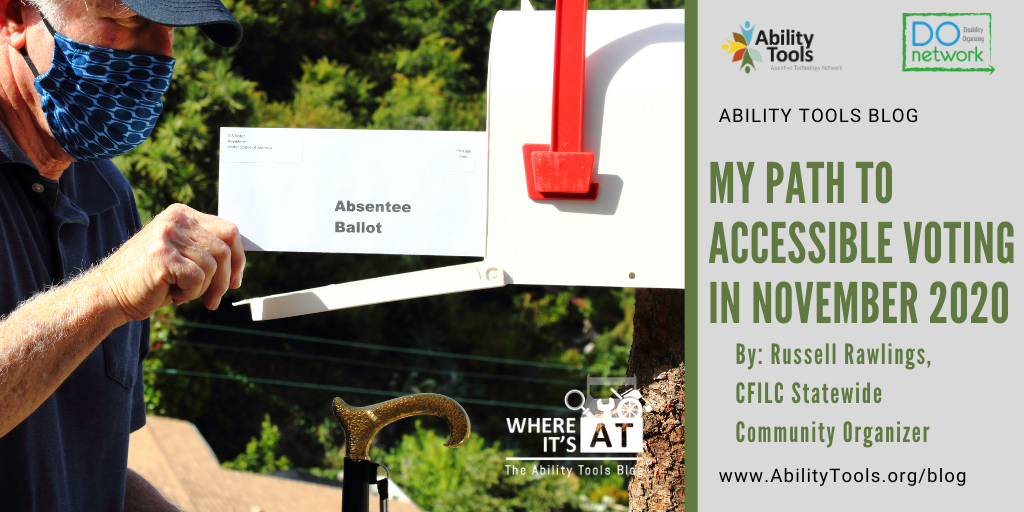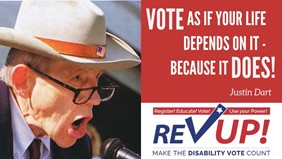In honor of National Voter Registration Day, Where it’s AT would like to reflect on the particular experiences voters with disabilities have when “going” to the polls, whether “going” to the polls means physically visiting a polling place, voting by mail, or any of the new emerging options. As our country progresses toward utilizing necessary technology to meet accessibility and safety needs, it contends with ensuring that every voter has the ability to have their voice heard on election day.

DOnetwork’s Statewide Community Organizer, Russell Rawlings, decided to share a long-view of his experience voting as a member of the disability community:
I am absolutely passionate about voting. The first time I read Justin Dart’s famous, if ominous, words on a poster at Resources for Independent Living, “Vote, as if your life depends on it — because it does,” I was moved. (And so was Beyoncé at the BET awards — check this out!) I was still in the early days of my independent living journey, but these words affected me profoundly. (Here’s a great video from the YO! Disabled & Proud archives about Justin Dart and his legacy!)

Up until that point, I had been an inconsistent voter at best. I knew it was part of my civic duty. I know that I voted in the first election I was eligible to do so. I was in Texas at the time, and I was completely reliant on my parents for transportation. If my memory is correct, I also needed their assistance in physically accessing and marking my ballot. So, transportation was one barrier to voting. The second was the act of actually… Voting. I believe I voted in Texas no more than twice.
When I moved to Sacramento, California in 2001, the first barrier that I conquered was transportation. Thanks to public transportation, I was given the freedom of travel in a way that I had not previously known. I knew that barrier to voting was conquered. (Also, did you know that California’s Voters Choice Act, SB 450, requires vote centers to be located near public transportation? While only certain counties have adopted the “vote center model” outlined in SB 450, its impact will eventually be statewide. Find out more about the Voters Choice Act here.)
But how was I going to vote? To be completely honest, I was not at all certain. I had been told it was my “right,” so I went with the assumption that I would figure it out when I got there. It wasn’t the first time that I had to just charge ahead and figure things out — had I not been willing to do so, I would not have been in Sacramento in the first place. (But that’s a much longer story for another time…)
I fully realized just how linked voting is to everyday life.
Sacramento County’s Voter Registration and Elections website has me listed as “Voted by Absentee Ballot” in October 2003 for a Statewide Special Election (the infamous recall election!) — I noticed that my voting frequency improves over time. In March 2004, I voted in person for the first time in California.
To be completely honest, I don’t remember it being easy. There was an “accessible” voting machine. It was in the corner, sitting unused. I remember the poll workers being friendly enough, but mostly unfamiliar with this device. While almost everyone else was in and out of the polling place in 15 minutes, it took almost twice that long for poll workers to set up the accessible ballot marking device. Luckily, the device was within my reach, although I did have to stretch quite a bit. It wasn’t easy!
Over time, I gained confidence both in voting and in life. By the time that I participated in Occupy Sacramento in 2011, I fully realized just how linked voting is to everyday life. (Yes, there’s more to civic participation than just voting, but the outcomes of elections can have profound effects… Remember the recall election I mentioned earlier?) I was committed to voting in every election because my right to do so had not come easily — for myself, or for others.

Quite a bit has changed since I started voting consistently in every election. Accessible voting machines have improved. (Here’s a list of voting systems, along with important information on how to use them, arranged by county.) For me in Sacramento County, the Voters Choice Act has been transformational.
I am now on the Sacramento County Voter Accessibility Advisory Committee, a position I obtained after joining RIL as Director of Advocacy. I am also leading the DOnetwork’s disability voting access work. (We have a series of webinars available here.) Neither of these would have been possible without the underlying access — accessible voting machines and public transportation.
In 2020, we’ve entered the age of the COVID-19 pandemic. I will not be voting the same way this year. For me, as an immunocompromised person, voting in person is not a health risk I’m willing to take.
I will be using the Remote Accessible Vote-By-Mail… all I will need to do is send an email or call to request a link to my ballot.
Instead, I’m going to take advantage of California’s Vote-By-Mail expansion. This year, I will be using the Remote Accessible Vote-By-Mail (known by the unfortunate acronym RAVBM or just AVBM) system. This means I will follow the instructions on Sacramento County’s Voter Registration and Elections “Accessible Vote By Mail” website — all I will need to do is send an email or call to request a link to my ballot. (They have a really cool demo site available here. Note that you cannot actually mark a ballot or vote from this link.)
But that’s just the decision I’m making for me. I know that if I wanted to vote in person, I would have a fully accessible experience at a vote center. I also know that the polling places will have educated workers doing everything they can, including use of Personal Protective Equipment (PPE), such as masks, gloves, and strict cleaning protocols. I know that if I have any trouble voting, I can call the Voter Registration and Elections Office, and you can too.
If you haven’t yet done so, I encourage you to Google “[your county name] elections office,” and search for in-person and Remote Accessible Vote-By-Mail options. Research your options, don’t hesitate to call your county elections office if you have questions.
If there’s something you’re still feeling uncertain of, I’m more than happy to help with a little research. This is all new territory for a lot of us, but it’s also a time of creative use of technology. If you have any additional questions or want to become a part of our effort to promote disability voting access, please send me an email at: [email protected].
Follow the DOnetwork on Facebook and Twitter — watch for the #DisabilityVoteCA hashtag!
If you would like to share your experiences, and encourage others to participate alongside you, please leave us a comment. We would love to hear from you!




